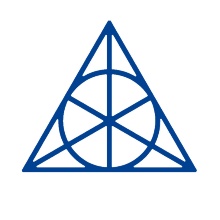You have written books on projective geometry, on locally compact groups, lectures on Lie algebras, on incidence geometry, and on group theory. Are you a geometer, or an algebraist, or a topologist?
For me, these three fields are closely intertwined; they benefit from each other. Results and methods from each of these fields can be very useful for studying the other two. This is by no means special: if you dig deep enough into mathematics, you will always benefit from other areas of mathematics. I think this is also due to the abstractness sought for in mathematics, which makes it easier to recognize concepts in entirely new contexts.
Specifically, using a very small example:
The logo of our university's
Student Council
Mathematics (the "Fachgruppe Mathematik") can be interpreted as a representation of the
projective plane of order 2 - so it belongs to incidence geometry.

The logo can also be read as a representation of the set of all vector subspaces of a three-dimensional vector space over the field with 2 elements - now we are in (linear) algebra. And in any case, the logo is perfectly suited for understanding the second smallest non-commutative simple group: the group PSL(3,2).
You are director of the Teaching Export Center for Mathematics (LExMath) and regularly give the lectures on Higher Mathematics 1/2 for engineering majors. Perhaps you can help us: How can you convince someone that imaginary numbers actually exist?
During the search for zeroes of algebraic equations one notices that the domains of natural, integer, rational, and even of all real numbers do not suffice for a satisfying arithmetical theory. I would then start with a construction that alludes to geometric experience: for pairs of real numbers (i.e., points in the plane) you specify addition and multiplication. Addition is no big surprise, multiplication takes some getting used to. You should then spend some time with this construct to get a feeling that the geometric interpretation in the plane helps you to understand this new computational domain more deeply. Every now and then, a student of mathematics should also think about general algebraic structures, and study the role of topology in the construction of the field of real numbers - we find ourselves confronted with the initial question, again...
There is a figure of speech; we "grasp" a mathematical idea.Can we take this literally?
I think it is not a mere coincidence that such a descriptive way of speaking is used for a mental process: geometric imagination is essentially supported by earlier experience in playing with building blocks (if one was allowed to have such). For teaching mathematics, I have therefore been constructing various models (e.g. of quadrics, or of graphs of functions in two variables) for some years now. These models are real existing objects from the 3D printer. We hope they help to bring abstract mathematics within reach (again, meant literally) in discussions and lab sessions.
Is it actually difficult to stage a lecture with 2600 participants?
Yes, sure! But I'm not left to my own devices; over the years, I have been strongly supported by Norbert Knarr, Matthias Künzer, Boris Krinn, Anna Sändig, Dominik Zimmermann and the many staff members and tutors who were or are still involved in these events. Nevertheless, I am glad that the numbers are going down again and that the lectures no longer have to be divided into four groups to be teached in separate lectures while keeping their progress in parallel.
You like to take discovery tours on the Vaihingen campus. Some mathematical content in works of art to be found there was brought to the attention of viewers in a tour. But flora and fauna also thrive here. Would you share a photo?
Yes, with pleasure! Here is a starling (captured on the parking lot behind the PWR7 building):

The questions are asked by Priv.-Doz. Dr. Matthias Künzer
Prof. Markus Stroppel
Head of the Teaching Export Center Mathematics


